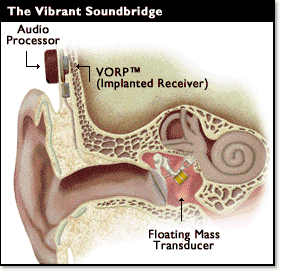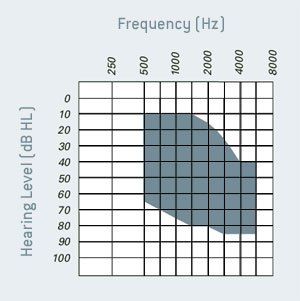|
Vibrant Soundbridge:
Middle ear implants are a recent innovation and can be totally or partially implantable. The Vibrant Soundbridge is a partially implanted device. A transducer is surgically attached to the ossicles in the middle ear. Sound is detected by a microphone in the audio processor, digitised and the signal transferred to a receiver surgically implanted beneath the skin. The signal is then transmitted to the transducer which vibrates, moving the ossicles and transferring energy to the cochlea.
.Figure 2. Middle Ear Implant


Indications: These devices are suitable for patients (adults and now also children in the EU) with mild to severe sensorineural hearing losses as shown below.

Some patients cannot wear hearing aids due to infections, abnormal ear canals or inability to tolerate a hearing aid, and for these a middle ear implant may be a solution.
Advantages: Why should someone want a middle ear implant as opposed to a conventional aid?
There is less feedback and whistling with these devices, allowing greater amplification.
They do not block the ear canal so patients get less echoing of their own voice.
Because the ear canal is not blocked, it is less likely to become sweaty, moist and infected.
It is claimed that sounds seem clearer and more natural than with a conventional hearing aid.
They are more comfortable, and of course the cosmetic appearance is also a factor.
Over 1000 people worldwide have been implanted with the Soundbridge device and the vast majority continue to use it.
Extended applications: More recently, middle ear implants have been used for mixed and conductive losses, and novel approaches such as round window positioning, treatment of otosclerosis, and combined middle ear implants with ossicular prostheses have been used with promising results.
Disadvantages:
The cost of implanting these devices is undoubtedly greater than the cost of a hearing aid.
MRI scanning of the head and neck is contra-indicated with the implant in situ.
There are always risks associated with surgery, including anaesthetic risks and specific risks associated with middle ear surgery.
There is a theoretical risk of potential long term damage to the ossicles or hearing, as constant movement against the ossicles may cause erosion of the ossicles, and non-physiological stimulation may cause inner ear damage. These devices have been used for the last 15 years so longer term data is not available, but the information available so far suggests that this not a significant problem.
|

